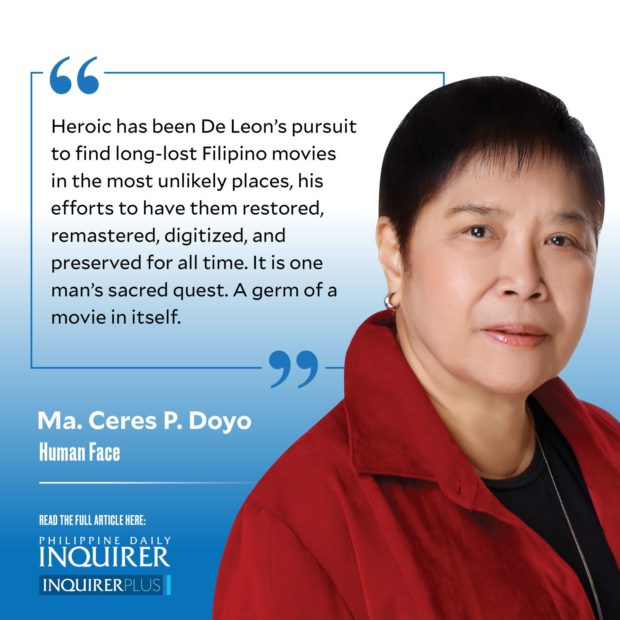‘Mike de Leon’s Last Look Back’
Very rarely, if at all, does one person embark on a monumental book project that requires not only a keen memory, a gift for storytelling, an eye for history, but also intrepid digging into treasure troves so enormous and confounding, if not in danger of vanishing. The book should have a place in a space time capsule and in libraries big and small.
“Mike de Leon’s Last Look Back” (the full title) consists of the author’s recollections as a third-generation heir to what remained then of the LVN Pictures Inc., one of the “big three” movie producers of bygone decades. It includes hundreds of rare photographs, movie stills, and memorabilia—a visual feast—generations may never get to see if they weren’t in De Leon’s two-volume (4 kilograms, 637 pages, 9 by 11 inches) “photographic memoir” that came out last December.
Credits go to Tony Rayns’ profound introduction and editor Patrick F. Campos’ piece on the book’s becoming and historical importance. De Leon is a renowned movie director and producer (also a scriptwriter and cinematographer), an auteur whose award-winning movies, blockbuster or not, created a niche in the Philippines’ movie history. “MDL’s LLB” is like no other.
Here is great storytelling, how memoirs should be, if you ask me. It flows, page after page. I dived into the written opus without let-up, even while the full-page screen grabs, photos of movie stars and movie sets were crying for attention. I stopped only to examine photos of myself on pages 71 and 347. (Indulge me.)
De Leon recounts how he grew up in the so-called studio system of decades past, at the feet of his grandmother, Doña Narcisa “Sisang” de Leon (she with the iconic baro’t saya), who founded and ran LVN Pictures, later taken over by her son Manuel, Mike’s father. After forays in Europe, De Leon would choose to take on the task of movie-making himself. Was it DNA or was it birthright? His upper-class upbringing and education (Ateneo de Manila, then Germany) notwithstanding, De Leon went down to the trenches in order to bring stories to the big screen. In contrast to his lola’s blockbuster musicals and costume movies and his father’s practical preferences, De Leon’s went for the jugular and the solar plexus. His were to shake, rattle, expose, and, why not, to also entertain. (Stanley Kubrick, American, WAS his favorite director. Now it is Yasujiro Ozu, Japanese.)
De Leon had an ear close to the ground and had been on a watch list. Proof was his brief detention and interrogation in a military camp during the Marcos dictatorship. A tipping point for him was the 1983 assassination of Sen. Ninoy Aquino. De Leon filmed the funeral attended by hundreds of thousands of mourners.
The dam had already burst earlier when Imelda Marcos’ hurried construction of the Manila Film Center (for her whimsical Cannes-like version of a film festival) collapsed and buried countless of workers, many of them never to be found. The frivolities in the name of art of the powers that be of that era get scathing interjections from De Leon. He names names.
Ah, the quotes, straight from his memory, some incriminating, others unnerving and hilarious. Like his face-to-face exchange with the Board of Censors’ head over a pajama scene in “Kisapmata.” A ^#@?*&!- moment.
De Leon had had to cope with consequences, censors, nervous producers, compromises. At the 1981 Directors’ Fortnight in Cannes where each participating director was asked “What is the future of cinema?” De Leon recalls: “Coming from a country like the Philippines in the grip of Marcos, I found the question irrelevant. I think mine was the shortest answer. I couldn’t wait to get out. That was 39 years ago. I still find that question absurd today.”
De Leon writes with subtle restraint about his privileged childhood, his family (he provides photos) and rare, heart-tugging moments with his father in adulthood. But for his coworkers in movie-making, De Leon pours out only gratitude, and names them like they are family. “MDL’s LLB” is dedicated solely to the late Cesar Hernando (1946-2019), movie production designer of note.
De Leon devotes chapters to chosen movies, among them, Lino Brocka’s groundbreaking “Maynila sa mga Kuko ng Liwanag,” which De Leon coproduced with Severino Manotok Jr. and for which he did the cinematography. “Kisapmata,” “Batch ’81,” “Citizen Jake,” “Aliwan Paradise,” “Signos,” (an antidictatorship documentary), “Sister Stella L.,” “Bayaning 3rd World,” and more. A photo from “Aliwan Paradise,” a mind-blowing allegory, is Book 1’s frontispiece.
“MDL’s LLB” provides an index and a filmography, a list of 141 movies mentioned, with details and screen grabs, a bonus for cineastes.
Heroic has been De Leon’s pursuit to find long-lost Filipino movies in the most unlikely places, his efforts to have them restored, remastered, digitized, and preserved for all time. It is one man’s sacred quest. A germ of a movie in itself.
In a solemn moment toward the end of the journey, nostalgia takes over. The reader beholds the scene from a distance while De Leon watches alone the last of LVN Pictures’ walls being leveled to the ground, the inexorable end of an era.
To order the book, send email to llbcontramundum@gmail.com, or call 0945-280-7893.
——————-
Send feedback to cerespd@gmail.com






















